 Jordan: Devices to reduce west Amman water consumption
Jordan: Devices to reduce west Amman water consumption
A total of 1,200 houses in west Amman, which consumes over 20 per cent of the capital's water allocation, are now equipped with water-saving devices.
Under an ongoing campaign launched in July, over 2,000 devices were distributed and installed free of charge to reduce consumption at households in western Amman neighbourhoods including Um Uthaina, Sweileh, Sweifieh, Shmeisani, the Sports City area and Khalda.
The target of the campaign, which was launched by HSBC Bank, USAID and Jordan Water Company (Miyahuna), was to install the devices in 2,500 households, but organisers said the number of recipients has been reduced as "standard houses" in target areas needed more devices than expected.
"Most of the houses in these areas have three or four bathrooms which means more water-saving devices… one of the houses in Khalda even had 13 bathrooms, so we have adjusted our strategy," said Nada Heeti, account executive at Seif International Marketing Services, the company tasked with installing the devices.
Heeti added the total number of recipients will drop to 2,000 households.
The campaign, titled "Yalla Nwaffer Mai", or "Let's Save Water", seeks to install the water-saving devices as well as build awareness on the need to conserve water in Jordan, which is categorised as the fourth water-poorest country in the world.
The initiative, which ends this week, targets neighbourhoods with consumption rates exceeding 90 cubic metres of water every three months, according to Miyahuna officials, who said the average household water consumption ranges between 60 and 70 cubic metres.
According to USAID-funded IDARA Project Chief of Party Mohammad Chebaane, studies indicate that 50 per cent of water consumption comes from taps, half from kitchen taps.
Chebaane added that water consumption originating in kitchens in homes across the country is 25 per cent higher than the international average.
Campaign organisers expect the devices to cut water use by 30 per cent and reduce water bills. At the end of the year, water gauges in participating households will be measured in order to determine how much water was saved.
Miyahuna pumps around 408,000 cubic metres of water to Amman daily from several water sources, such as Zara Maeen, Qastal wells, Qatraneh, Swaqa and Zai Water Treatment Plant.
| Contact information |
Hana Namrouqa
|
|---|---|
| News type | Inbrief |
| File link |
http://www.jordantimes.com/?news=19249 |
| Source of information | Jordan Times |
| Subject(s) | DRINKING WATER , DRINKING WATER AND SANITATION : COMMON PROCESSES OF PURIFICATION AND TREATMENT |
| Relation | http://www.emwis.net/countries/fol749974/country045975 |
| Geographical coverage | Jordan |
| News date | 02/09/2009 |
| Working language(s) | ENGLISH |
 you are not logged in
you are not logged in





